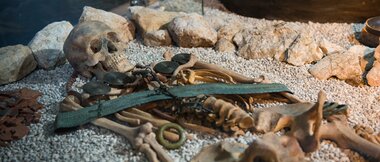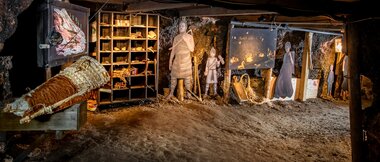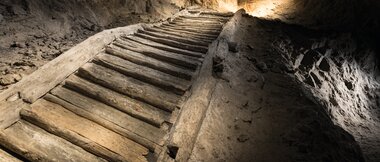The oldest salt mine on Earth promises lots of fun in the world of today
The history of the town of Hallstatt is inextricably interwoven with the history of salt mining which, extending back some 7,000 years, is even a good bit older than the famous UNESCO World Heritage-listed town itself. Though despite all of those historic millennia – or perhaps, precisely because of them – a visit to Salzwelten Hallstatt isn’t old-fashioned in the slightest: Here, you immerse yourself in a fascinating and adventurous subterranean realm – seasoned with a healthy pinch of salt and enjoyment!
An adventure-packed history that begins 7,000 years ago
As we said: The history that salt mining in Hallstatt looks back on, is absolutely unique worldwide. During the Neolithic Age – an almost incomprehensible 7,000 years ago – people were already busy here mining for salt. That makes Hallstatt the oldest salt mine in the world! Later, people equipped with the simplest of tools were digging tunnels 200 meters deep into the mountain, even building staircases to help transport “white gold” out from deep inside the mountain. And let it be said, the comparison with gold is more than fitting, since salt used to be an extremely valuable natural resource. For with salt, it was possible to preserve foods. And ultimately, those who had enough to eat were able to survive. The finds from the world-famous burial grounds in the Hallstatt high valley attest to the “salty” prosperity of prehistoric times. It is due to those graves as well as archaeological finds preserved perfectly due to the special climate inside the mountain, that this epoch was given a name uniquely its own: the “Hallstatt Age”.
A success story: from the 16th century until today
The prehistoric heyday of salt mining was followed by a period of stagnation: In roughly 350 BCE, a landslide buried the high valley under meters and meters of debris and mud – only the burial grounds were spared. Salt mining was then abruptly shifted to a different location. Beginning in the 16th century, salt production in Hallstatt experienced yet another boom: From 1600 until 1960. Hallstatt was the most important mining location in the entire Salzkammergut Region! Whilst 313 people were still employed at the mine above Lake Hallstatt in 1909, in 1965 the Hallstatt saltworks was forced to close. However, brine is still produced at this location: roughly one million cubic meters annually. Via a 40 km long pipeline system, the brine flows all the way to a salt works in Ebensee, where it is then turned into a wide variety of salt products. Incidentally: This brine pipeline was built in 1595, making it the oldest pipeline in the world. That said, the Salzkammergut is the oldest industrial and cultural region worldwide, salt having been continuously produced here for over 7,000 years until the present day. In turn, Salinen Austria AG is one of the oldest commercial enterprises in the world. And the mine? As a visitor, you can take all the time in the world to visit the mine in search of adventures and fascinating history!
Salzwelten Hallstatt: an adventurous slide down through the millennia
A visit to Salzwelten Hallstatt is like an hour-and-a-half journey back in time through 7,000 years of history: When you feel the roughly hewn tunnel walls under your hands. When you slither down the 64 meters-long miners’ slide. When you rattle along on the mine train back into the daylight. But: 400 meters below ground, state-of-the-art multimedia technology also does its part to bring Bronze Age mining vividly back to life.
Look at that! What does the oldest staircase in Europe have to do with the Bronze Age Cinema?
Did you know that the oldest wooden staircase in Europe is located at Salzwelten Hallstatt? In fact, it is almost 3400 years old! Naturally, nobody trudges up and down those stairs anymore, but you can still marvel at this structure in the Bronze Age Cinema. Cinema and Bronze Age? How on Earth do the two go together? It is easily explained: In 2002, the wooden staircase was discovered in the prehistoric part of the mine. Investigations conducted by scientists from Natural History Museum Vienna showed that people were using these stairs to lug “white gold” out of the mountain in the year 1344 BCE. Today, this valuable exhibit has reclaimed its rightful place 400 meters below ground, in the “Bronze Age Cinema”. A realistic animation projected onto the original exhibit brings the arduous working routine of Bronze Age miners back to life. You almost feel you are standing right there in the middle of the bustling action, 3400 years ago. In this way, the Bronze Age Cinema harnesses high-tech knowhow to build a bridge between the past and today.
Special Tip: a VIP Tour to secret places & hidden treasures
Would you like to experience Salzwelten Hallstatt exclusively and in a small group? With your own private guide? A guide who will lead you to locations away from the regular tour route? Who will tell you background stories? In that case, a VIP Tour of Salzwelten Hallstatt will be perfect for you! With a private guide, you will explore the hidden mysteries of the oldest salt mine in the world. Your guide will pick you and your VIP group (max. 10 people) up directly from your reserved parking space by the Salzbergbahn, then ride with you up to the high valley. If you let us know about your special interests beforehand, we will also adapt the focus of the tour accordingly. One cool highlight already awaits you in the VIP Room: Equipped with VR headsets, you will begin a 3-D discovery tour of the Bronze Age mine. This four-hour VIP tour is intended for those who believe they have already seen it all! Registration and additional info: +43 (0) 6132 200 2400 or info@salzwelten.at
In Salzwelten Hallstatt, the whiff of history accompanies every step you take! But let’s not forget, a visit to the mine is also really good fun! Now is the perfect time to buy your ticket for Salzwelten Hallstatt and everything it includes:
- admission and guided tour of Salzwelten Hallstatt
- panorama lift and scenic bridge
- “World Heritage View” skywalk viewing platform
- exhibitions in Rudolf’s Tower and the Knappenhaus
- visit to the showcase grave
- theme path across the Hallstatt high valley “Pathway through Time” with additional info provided on the free audio-guide app
Milestones of latter-day mining in Hallstatt
|
|||||||||||||||||||||||||



